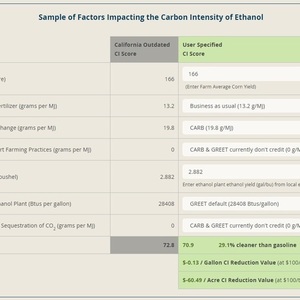ACE introduces CI calculator to showcase ethanol's GHG benefits

SOURCE: American Coalition for Ethanol
June 10, 2022
BY American Coalition for Ethanol
The American Coalition for Ethanol has introduced a new carbon intensity (CI) calculator to help its members understand the carbon intensity (CI) of their farms and ethanol operations along with a simplified version of the tool to raise awareness about factors impacting the CI of ethanol. Combined, these tools help illustrate corn ethanol’s ability to attain net-zero and net-negative greenhouse gas emissions.
The topic of carbon intensity can generate confusion because various regulatory bodies (EPA, CARB, etc.) apply different approaches to derive carbon scores. What’s more, some regulatory bodies use outdated lifecycle factors to overstate ethanol’s CI, causing understandable apprehension from producers about new clean fuel policies. ACE’s detailed calculator allows users to break through this confusion by using their own corn farming and ethanol production information to estimate a carbon score and compare it to the Argonne National Laboratory’s GREET model and average scores used by the California Low Carbon Fuel Standard.
"When I first looked at the GREET model's ‘Midwest average’ carbon intensity for corn production, I immediately saw the potential for rapid reductions with more accurate modeling that reflected actual climate-smart production practices being employed by tens of thousands of farmers across the Midwest,” said Ron Alverson, calculator creator, farmer, Dakota Ethanol and ACE Board Member. “The CI calculator we developed at ACE is a tool for farmers and ethanol producers to see for themselves what their potential is to lower their carbon score.”
“ACE is focused on highlighting how climate-smart farming practices, efficiencies at ethanol plants, and the capture and sequestration of CO2 from facilities puts ethanol on a trajectory to reach both net-zero and net-negative emissions; a trajectory unique to ethanol,” said Brian Jennings, ACE CEO. “The calculator is not only useful for farmers and ethanol producers who want to know their CI score, it also helps ACE highlight the need for farm-level practices to receive carbon benefits in clean fuel markets.”
Advertisement
Advertisement
Join ACE for a walk-through demonstration of how the carbon calculator works at the Fuel Ethanol Workshop in Minneapolis on June 14 from 1:30-3:00 p.m. in room 207A. FEW attendees can also visit the American Coalition for Ethanol booth #1201. RSVP to Katie Muckenhirn to attend the in-person demonstration at the FEW.
Advertisement
Advertisement
Related Stories
The U.S. Energy Information Administration maintained its forecast for 2025 and 2026 biodiesel, renewable diesel and sustainable aviation fuel (SAF) production in its latest Short-Term Energy Outlook, released July 8.
XCF Global Inc. on July 10 shared its strategic plan to invest close to $1 billion in developing a network of SAF production facilities, expanding its U.S. footprint, and advancing its international growth strategy.
U.S. fuel ethanol capacity fell slightly in April, while biodiesel and renewable diesel capacity held steady, according to data released by the U.S. EIA on June 30. Feedstock consumption was down when compared to the previous month.
XCF Global Inc. on July 8 provided a production update on its flagship New Rise Reno facility, underscoring that the plant has successfully produced SAF, renewable diesel, and renewable naphtha during its initial ramp-up.
The U.S. EPA on July 8 hosted virtual public hearing to gather input on the agency’s recently released proposed rule to set 2026 and 2027 RFS RVOs. Members of the biofuel industry were among those to offer testimony during the event.
Upcoming Events










